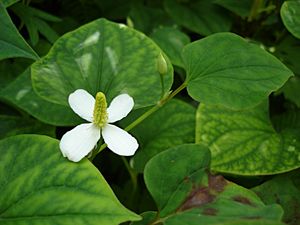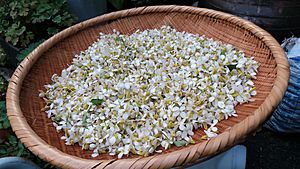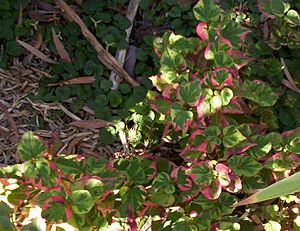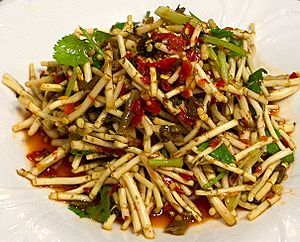Fish mint facts for kids
Quick facts for kids Fish mint |
|
|---|---|
 |
|
| Scientific classification | |
| Genus: |
Houttuynia
|
| Species: |
cordata
|
Houttuynia cordata, also known as fish mint or chameleon plant, is a type of flowering plant. It is one of two species in its group, called Houttuynia. This plant originally comes from Southeast Asia. It likes to grow in places that are wet and shady. The plant was named after a person called Martinus Houttuyn.
Contents
How it Grows
Houttuynia cordata is a herbaceous perennial plant. This means it has soft stems (not woody) and lives for more than two years. It can grow to be about 2 to 3 feet (0.6 to 1 meter) tall. It can also spread out up to 3 feet (1 meter) wide.
The bottom part of its stem grows along the ground and can sprout new roots. The top part of the stem grows straight up. Its leaves are shaped like a heart. They are about 1.5 to 3.5 inches (4 to 9 cm) long and 1 to 3 inches (3 to 8 cm) wide.
The plant's flowers are greenish-yellow. They grow on a spike at the end of the stem. This spike is about 0.75 to 1.25 inches (2 to 3 cm) long. Around the flowers, there are four to six large white leaf-like parts called bracts. It usually blooms in the summer.
This plant is sometimes called an invasive plant. This is because it can spread very easily. Even small pieces of its roots or stems can grow into new plants.
Growing the Plant
Houttuynia cordata grows well in wet soil. It can even grow a little bit under water. It needs to be in a place where it gets some sun or full sun. When grown in gardens, it can spread quickly. It can be hard to remove because its roots go deep and spread out. You can grow new plants by dividing its roots.
Gardeners often grow special types of this plant. The 'Chameleon' variety is a popular one. It has leaves with different colors like yellow and red. This type does not spread as fast as the main species. Another common type is 'Flore Pleno'. It has many white bracts and grows just as strongly as the original plant.
Houttuynia cordata has also started growing naturally in North America.
How People Use It
Cooking with it

This plant is often grown as a leaf vegetable. People use its fresh leaves as a garnish or a herb. The leaf has a unique taste that some people describe as 'fishy'. Because of this, not everyone enjoys it as much as herbs like basil or mint.
In northeastern India, people use it in salads or salsas. They also cook it with other vegetables. It is used as a garnish on side dishes. The soft roots can be ground into chutneys. These chutneys are made with dried meat or fish, chilies, and tamarind. People eat it raw in salads or cook it with fish in curries.
In Japan and Korea, people dry its leaves to make an herbal tea. They believe this tea has healing properties. In Japan, this tea is called "dokudami-cha."
In Vietnamese cooking, it is called diếp cá. It is used with grilled meat and noodle salads. Fish mint can be a garnish for many Vietnamese dishes. Examples include gỏi cuốn (spring rolls) and bánh xèo (savory pancakes).
In southwestern China, the edible root of Houttuynia cordata is called Zhé'ěrgēn. It has a fresh, spicy, and peppery taste. It is used in the cooking of places like Guizhou, Sichuan, Yunnan, and western Guangxi. In Sichuan, people usually eat the leaves. In Guizhou, they eat the root. A common dish in Guizhou is Zhé'ěrgēn fried with cured la rou (a type of dried meat).
Some ways Zhé'ěrgēn is used include:
- It is part of the many fried rice dishes in Guizhou.
- It is added to migan and mixian noodles served in broth.
- It is used in dipping sauces for barbecued tofu in Shiping and Jianshui.
- People eat it raw in cold salads. It is often mixed with coriander, vinegar, fresh chilli, and soy sauce.
The leaves are also a bit peppery and are often eaten in these regions.
Traditional Medicine
Houttuynia cordata has been used in traditional Chinese medicine for a long time. People in China have explored its use for various health issues. However, there is not enough scientific research to fully confirm if these uses are safe or effective.
Aroma of the Plant
The special smell of Houttuynia cordata comes from certain chemicals inside it. Two of these chemicals are called beta-myrcene and 2-undecanone.
Images for kids
See also
 In Spanish: Houttuynia cordata para niños
In Spanish: Houttuynia cordata para niños




